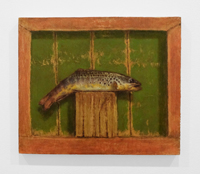JTF (just the facts): A total of 31 black and white and color photographs by Justine Kurland, framed in white and matted, and hung against white walls in the main gallery space and the entry area. The 30 black and white works are gelatin silver prints, made between 2016 and 2018. Each is sized roughly 6×7 inches (or the reverse) and is available in an edition of 6. The single color work is a c-print, made in 2017. It is also sized roughly 7×6 inches and is available in an edition of 6.
The show also includes 8 paintings (oil on panel, some with additional collage elements) by Bruce Kurland (the photographer’s father), variously framed, made between 1973 and 2012. The works range in size from roughly 10×8 to 13×15 inches and are unique.
A risograph zine entitled Airless Spaces has been published by Rock Bottom in conjunction with the exhibit and is available from the gallery for $20. In an edition of 50 copies.
Comments/Context: In the past few years, Justine Kurland’s photographic career has taken a dramatic turn, at least in terms of her approach to the medium. If we use her artistic output over the past two decades as a guide, most will know Kurland as a road trip photographer of sorts, heading out in her van with her young son and her 4×5 camera, following trains into Edenic natural settings and arranging her subjects (from runaway teenage girls and commune farmers to female-centric families and men with their cars) into scenes that carefully mix the documentary with the allegorical.
But in pictures made in the past three years, Kurland has parked the van in the garage, said goodbye to the embrace of nature (at least for the moment), and returned to more personal photographs made indoors. In 2015, she released an intimate photobook of black and white images (Black Threads from Meng Chiao, published by TIS, here) in collaboration with John Yau. The pictures from that project are filled with the worn surfaces and textures of her East Village apartment, the closeness of the door frame, the sink drain, the gas stove burner, and her own nude body providing the subject matter for photographs that use formal relationships to explore the feeling of being tightly hemmed in.
Her newest pictures continue along this same trajectory, slowly and tentatively expanding out into various adjacent themes and ideas in a search for a new path forward. In reducing and paring back, looking for the core, she has done what many of us might do – she has, at least partially, returned to home and family.
This show pairs her photographs with paintings by her father Bruce Kurland, and there is a clear sense of Justine rediscovering the formal ideas embedded in his paintings, almost as if she was re-seeing them for the first time. Her father’s still lifes are enlivened by small incongruities and unexpected combinations – uncooked bacon draped from a Coke bottle, shrink-wrapped meat perched in a bowl, spears of asparagus set on top of a Budweiser can, and a trout hanging limply over a wooden block – and a few of Justine’s photographs explore this same kind of unconventional aesthetic thinking. She sets a used tampon on a sheet of paper amid flakes of paint, arranges a tooth mold on the edge of a sink, looks closely an an overflowing ashtray, and notices a bedsheet curtain repaired with black duct tape. The most resonant of these still lifes is one depicting a crusty black snake skin placed on the slats of a wooden chair, the symbolic idea of sloughing off an old identity a convenient parallel to the process of charting a new artistic course.
Justine’s mother provides a different line of inspiration. In a series of portraits and nudes, Kurland casts her mother as the primal life giver, the “origin”, her aging body still the essential unwavering starting point of her daughter’s journey. Like her close observations of her father’s paintings, these images feel like rediscoveries, the mother and her small human realities now seen with freshly attentive eyes. Related pictures of animals (seemingly a pet cat and dog) get similarly close to their natural reproductive frailties, their bellies alternately shorn due to pregnancy and recent medical procedures.
The themes of Kurland getting back to basics and trying to find new artistic directions come through again and again in this body of work. She looks outside, finding buildings in decay (an abandoned Nestlé factory) and houses literally boarded up, their windows covered in plywood, forcing a return inward and inside. She makes images that pay homage to her many artistic influences, from Harry Callahan (Eleanor-like poses) to Hannah Wilke (chewing gum additions), perhaps in the hopes of finding new ways into their durable truths. And she experiments with more expressive and unvarnished self-portrait nudes, seeing herself with less control, the images of masturbation, sex, and menstruation connecting to the primal cycles she observes in other pictures.
Seen as an integrated group, these photographs feel like directed wandering through a period of transition, the artist working through various ideas and trying to find that spark of inspiration that will take her off somewhere new. While consistently well-constructed and intimate (the small size of the prints pulls us in close), my guess is that these pictures will ultimately feel like a bridge or an interlude, a stopping point for recalibration between the first part of her career and what will become the next chapter. They stand alone as a thoughtful story of conscious introspection and deliberate reconsideration, but more likely serve as a patient intermission between artistic acts.

